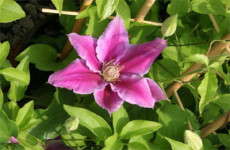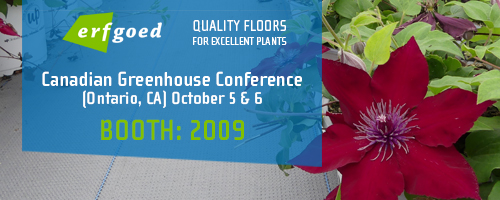Tips For Producing Clematis

The information outlined below is general information for container-grown clematis. Your actual cultural conditions may vary. Clematis are classed as a hardy flowering vine. Their requirements change throughout the year. Container clematis performs better during the brightest times of the year under approximately 30 percent shade. They will tolerate extended periods below freezing if managed properly. Clematis requires a dormancy period, which we refer to as the vernalization period. Proper vernalization is important for vigorous growth.
Our clematis plugs and 4-inch liners should be planted 0.50 inches below soil level. They should be planted in a well-drained media composed of bark and Canadian peat with a pH between 5.5 and 6.5. Other media that you grow perennials in can work as well. The liner trays should be watered before planting, and the pots should be watered immediately after planting. The soil should be amended with a medium-term well-balanced fertilizer such as Nutricote 18-6-8 at 8 to 10 pounds per yard. Even at these rates, liquid feed can be used to supplement the fertilizer program. Don’t let the pH rise over time.
Irrigation Requirements
Clematis prefers to dry down moderately. Repetitive irrigations that keep the crop saturated will lead to problems. Edge watering may be needed to keep the crop evenly irrigated. During the dormant period (November through March) they will need much less water. At this time, dryer is better than wetter. If the crop will receive sustained below-freezing temperatures, they must be well watered before this time.
Temperature Requirements
If you are receiving vernalized plugs or liners and planting in January or February, for best results night temperatures should be kept at or above 40°F and day temperatures should not be allowed to get above 85°F. If you transplant in the summer and fall, you will need to overwinter the crop. This is best accomplished in a structure that can be kept at 32°F during the night and should not be allowed to get above 50°F (if possible) during the day. After eight to 10 weeks in these conditions the plants can be warmed up and will start to grow.
Insect Pests And Diseases
Pests on clematis include mites, caterpillars, mealybugs, snails and aphids. Safe chemical insecticides/miticides include Sandmite, Floramite, Sevin, Closure, Mesurol and chloropyrifros. Fungicides that seem to be safe include Contrast, Medallion, ChipcoGT 26, Subdue Maxx, Dithane and Kocide. Always read the label.
Vernalized 50-cell plugs planted in the early spring will finish a 4-inch pot in eight to 10 weeks. Vernalized 4-inch pots are recommended for finishing a 6-inch/1 gallon pot from an early spring planting. Vernalized 4-inch plants will flush to finish in six weeks. They will finish a 6-inch/1 gallon pot in six to eight weeks.









